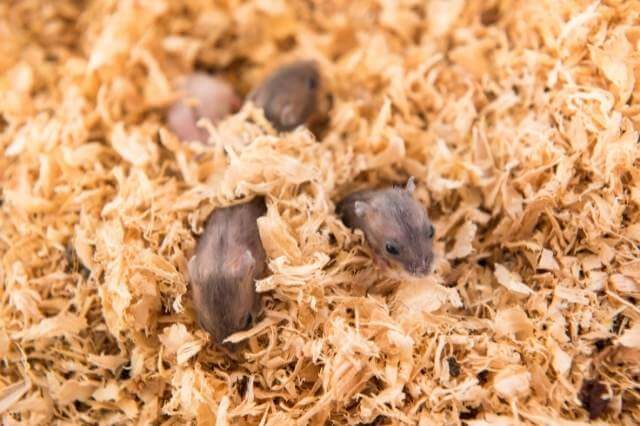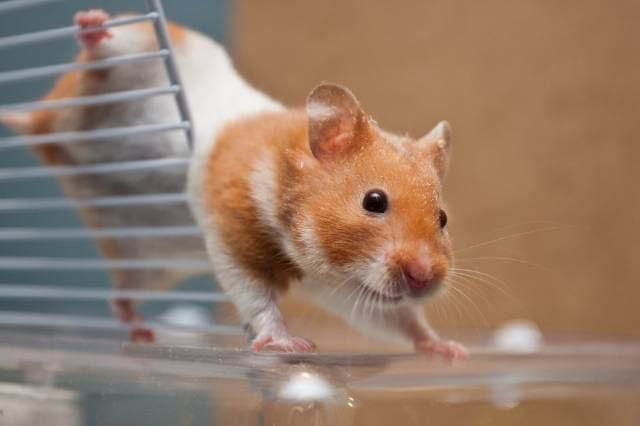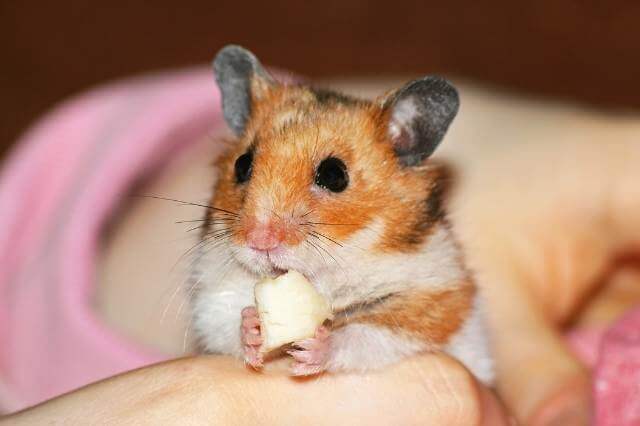Since hamsters live brief lives, their life cycles are shorter.
Make careful to keep males and females apart from an early age since you might be shocked by how old hamsters can become pregnant.
Male hamsters become viable at only 4 weeks, while female hamsters can get pregnant as early as 6 weeks of age.
Don’t breed a female until she is at least 10 weeks old.
Male hamsters are fertile for the entirety of their lives, whilst females can get pregnant for 12 to 16 months.
24 hours after giving birth, hamsters are capable of becoming pregnant once more, albeit they are rarely motivated to do so.
After giving birth, your hamster will require help, and you’ll have to take care of the young.
Table of Contents
Can Hamsters Get Pregnant Without a Male?
No. A hamster has to be mated in order to give birth to offspring. Purchase two hamsters first. The breed should be the same.
Let them play together in the same cage. They will soon become parents as they grow closer.
For a female hamster to get pregnant and give birth, there must be a mating.
This hamster could have been carrying a baby when you purchased her from the pet shop.
If her abdomen appears swollen but she is not pregnant, get her checked out by a veterinarian.

The Ideal Period for Your Hamster to Give Birth
Make sure your female hamster is the right age if you’re still considering breeding hamsters. Allowing her to mate too early is risky.
The majority of veterinarians advise hamster owners to wait to mate their females until they are at least 10 weeks old since this is when they are thought to be in the best condition.
Keep in mind that a female is only fertile and capable of becoming pregnant on day 2 of her cycle.
Otherwise, your female hamster could hurt any would-be suitors and the mating and fertilization of the eggs would be pointless.
Therefore, timing is crucial, and when you do add a guy into the mix, do so gradually and with close supervision.
Even though it’s crucial that no hamsters are hurt, it’s not unusual for the female to act violently toward the male.
She is putting him to the test to see whether he can fertilize her eggs.
Hamsters, like all other animals, have the genetic makeup to select the ideal spouse, which will eventually lead to their survival.
Is My Hamster Pregnant? How Do I Know?
The easiest techniques to determine whether your hamster is pregnant are as follows.
A vet will be able to answer your questions if you’re still hesitant.
Recent interactions between your hamster and a male?
Some species of hamster give birth fewer than 20 days after mating, hence their gestation periods are relatively brief.
Your hamster is not pregnant if it last interacted with a male more than 30 days ago.
There would already be a large number of young hamsters if the mating had been effective.
What is the hamster’s age?
At the age of roughly six weeks, hamsters can reproduce.
The females may already be pregnant if you’ve been keeping males and females together after six weeks.
If so, it could just take two or three weeks for their litters to arrive.
Males are fertile throughout adulthood, but females are not until they are fourteen or fifteen months old.
Is the big belly the result of an illness?
It’s essential to rule out a medical ailment as the cause of the big tummy if you suspect your hamster is pregnant.
Tumors rather than infants might be present if her tummy is bumpy.
Additionally, an infection, digestive troubles, cardiac concerns, or bladder stones might result in an enlarged abdomen.
Take your hamster to the vet for an examination if you think she could be pregnant.
This will let you rule out these different medical ailments, and should your hamster actually be pregnant, it will also enable the veterinarian to identify any issues, inform you how the pregnancy is progressing, and provide advice.
Avoiding stress
Make sure there is nothing upsetting in your hamster’s environment that might disrupt her if she becomes pregnant and gives birth to offspring.
Hamsters are among the numerous animals that eat their own litter when under stress, therefore any stress or change in environment at this period might be disastrous.
Ask your local veterinary clinic for further details and suggestions on this matter.
Nesting.
Your female hamster maybe constructing a nest for her young if she appears bigger than normal and is accumulating a lot of bedding in one spot.
Hamsters have a strong drive to build nests, so keep an eye out for this activity as the pregnancy develops.

How Can I Help a Hamster Have a Baby?
The birthing procedure must be handled by you.
The likelihood that the puppies will be born alive and healthy increases with the amount of effort you put into making your hamster comfortable.
Instead of utilizing a cage to start, prepare the birthing location by using a sturdy hamster tank.
Before fully cleaning the tank, take out all of the toys, accessories, and platforms.
Put a thick layer of bedding on the floor after the tank is clean and empty.
If you want to save money, use toilet paper that has been crumpled up or ripped.
Just keep everything on the ground; a hamster’s nesting at an elevated height can be hazardous owing to the possibility of falls.
When you believe your hamster is ready to give birth, place the birthing tank in a calm area and rehome her there.
Make sure the tank has treats high in protein and water for your hamster to drink.
Some instances include:
- Porridge.
- Small chicken pieces.
- Scrambled egg whites that have been cooked.
- Breadcrumbs that have been soaked in milk.
Give the pregnant woman some room after she is in the tank.
Avoid attempting to handle her since you will likely get bitten and such actions won’t be accepted.
Keep an eye out for repeated squeaks coming from the tank, since this might indicate that birthing is occurring.
You can keep your distance and see the birth, but avoid becoming engaged.
Per pup, the procedure might take up to 30 minutes.
After the procedure is finished, let your hamster relax and concentrate on taking care of the puppies.
How Many Pregnancies Can a Hamster Have?
We now know that a hamster may give birth to pups between the ages of 10 weeks and 12 to 16 months.
The duration of each pregnancy is one month, followed by one to two weeks of postpartum care.
As a result, a hamster might theoretically have 10–13 litters over her lifespan.
As hamsters require a break between being pregnant and giving birth to pups, such frequency is not recommended.

FAQs
Hamsters Do They Have Periods?
Although female hamsters do generate eggs that must be fertilized, they do not have monthly periods as we do.
Instead, they have a white discharge during their estrus cycle.
The window of opportunity for breeding only lasts for 12 hours throughout the night and is repeated every four days!
But don’t be deceived; given the chance, hamsters may breed quickly.
We highly suggest separating male and female hamsters at roughly 5 weeks of age if you don’t want hundreds of baby hamsters.
Female hamsters may begin reproducing once they are eight weeks old, and they are fertile for virtually the entirety of their lives.
Hamsters shouldn’t bleed throughout their monthly cycle.
If there is substantial blood flow during this time, it may indicate a problem, such as a urinary tract infection, and you should seek quick veterinarian care.
Why Did the Hamster Eat Her Babies?
If they feel threatened, mother hamsters will consume their young. The young may be eaten by the mother if she is ill.
The most frequent reason why a mother hamster eats her young appears to be stress.
Female hamsters will devour their young at any time from the moment they are born until they are approximately 14 days old, however, the likelihood that she will do so during the first few days is higher than it is when they are a few weeks old.
What Can I Do to Stop a Hamster From Eating Her Young?
The mother hamster needs to be left alone if you want to try to stop her from devouring her young.
Never stare at the infants, make an attempt to take the mother or the kids away, or mess with the cage.
Try to minimize the stress on the mother as much as possible by leaving the cage alone, providing food, checking the water, and leaving the cage alone.
Ensure that the cage is in a peaceful area without access from other pets, and make an effort to maintain a comfortable temperature.

Final Thoughts
Hamsters can’t have immaculate conceptions, thus females must mate with a male in order to get pregnant and give birth to pups.
Hamsters are adept escape artists and are propelled by an innate impulse to reproduce.
A male and a female kept in separate cages that are close to one another will use any chance to get to the other.
Hamster breeding is a serious duty that needs much training and consideration.
We advise keeping male and female hamsters apart to avoid any unplanned pregnancies.
If you decide to start breeding hamsters, make sure you get as much guidance as you can since you’ll need to know you have the resources—both time and money, and expertise—to care for several hamsters at once.

